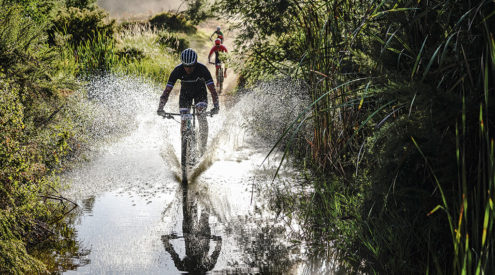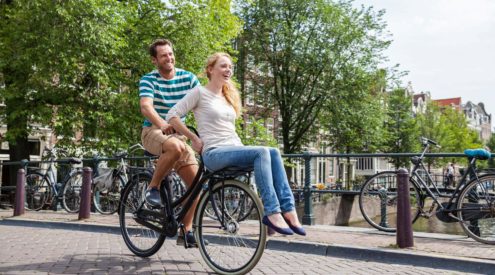We had to be at Customs in Kasane by 11h00. The customs office is situated right next to the Chobe River. Rafael, from Ichobezi River Lodge, met us here and loaded our luggage, including the two bicycles, in a little boat. From Customs on the Botswanian side we were taken up the river towards Customs on the Namibian side to get our passports stamped again. This is not a very busy border post. In fact, we were the only tourists there. I guess it is hard work trying to stay awake in such a relaxed working environment.
The boat trip to Ichobezi River Lodge is spectacular. There are hundreds and possibly thousands of open-billed storks on the banks and in the air. Hippos pop up every now and then. The vegetation is lush green. Nature seems to be untouched. Ichobezi River lodge is situated on Impalila Island, which is on the Namibian side of the Chobe River. Your luggage is carried to your room. A guide and boat is assigned to every group of guests which stay at the lodge, unlike all the other lodges in the area who take out several different groups of people in the same boat. It ensures that guests have an intimate natural experience without having to compromise their personal interests and getting frustrated. You choose what you want to do, whether it is fishing, a boat trip to view animals, birding, or photography. Fish are usually thrown back into the river after being caught. The guides are very professional and considerate. They pick up on your interest in no time, go slowly when the scenery is most beautiful, switch off the engine at sightings, give informative information. They know the birds very well, are careful not to compromise your safety at any time, do not disturb the animals but position the boat for the best photos possible. All you have to do is to absorb the incredible beautiful surrounding.
Ralph is the owner of Ichobezi River Lodge. He only employs young, local Namibian people who have never been employed anywhere else and gives them full training. In this way the local community benefits from the lodge.
Ralph’s daughter, Lisa, invited us to join them for the night on one of the two house boats. We had not been on a house boat before and were not sure what to expect. The house boats are enormous, with three levels. We slept in the main room and had a little veranda overlooking the river in front of us. Herds of grazing animals can be seen in all directions, including red lechwe, giraffe, sable antelope, hippo and elephant. The area is rich to a birding list of about 450 species, including specialities like purple heron, Carmine bee eater, African skimmer, red-throated pratincole, to name a few. Fish eagles are more numerous along this stretch of river than at most other water sources elsewhere in Africa.
Late afternoon we were taken for a boat trip by our guide, Raymond. Although hundreds of animals can be seen from the house boat it is not possible to get that close. A big herd of elephant moved down to the river bank for a drink of water. Some ellies ate trunks full of the mineral rich soil. More than one cow had extremely small babies with them. Another surprise awaited us just around the next bend of the river – a mother leopard with her cub. Nearby guinea fowl went crazy calling alarm, but the leopards were not fazed by it. The sun was setting in the distance. It was time to go back to the house boat to enjoy a lovely dinner.
Ralph lived in the area for more than 17 years. Cattle farming increased a lot over the past years due to better veterinary practices. Unfortunately, the farming practices leads to silting of the river system. Net fishing also increased dramatically due to a new type of cotton net from China, which allows the locals to catch far bigger loads of fish at one time. Where locals used to fish only for daily needs they are now fishing commercially. This allows them to live better lives, but put increasing pressure on the fish population in the river.
From the house boat the difference between the Botswanian and Namibian sides of the river is quite obvious. The Botswanian side is completely natural, lots of animals, but very dry and severely damaged by elephant. The Namibian side is green, only a few wild animals grazing on the banks, but many cattle and man made structures everywhere to be seen. Ralph believes that elephant have three basic needs: food water, and security, the latter taking priority. They will concentrate in areas where they feel safe. Ralph reminded us that elephant populations should not be managed over a yearly period, but rather over a 20 to 30 year period. This is because elephants have migration routes. They may stick to one area for a few years but may move to another because of natural cycles. That is why we need more transfrontier parks, to allow the animals to follow their ancient migration routes.
Our stay at Ichobezi River Lodge was not ‘great’, or ‘special’ and definitely not ‘nice’. I do not have the vocabulary to express how amazing it was! It was a once-in-a-lifetime experience, not only because of what we have seen and experienced, but also because of how the lodge is run and the staff managed. When you plan your next trip to Botswana or the Caprivi, do not miss out on this fantastic experience. It is very special, very unique and in the heart of nature. It is one thing to have a commercialized wildlife experience. It is completely something else to experience nature with people who love it dearly.
The next day we slowly made out way to the border between Zambia and Botswana and went over to Zambia by ferry. We got a lift to Livingstone and stayed for two nights at Jolly Boys back packers. Here we met two brothers, Simone and Phillip, who has been travelling with their bicycles from Spain to Morocca, and down the western part of Africa to Livingstone. They hope to finish in Cape Town.
Click here to book accommodation at Ichobezi River Lodge.

















